Assortments of some shops are full of exotic fruits. Many of them, most people have never seen or heard anything about them in their lives. One of these products is pitahaya - an outlandish, bright and very unusual fruit. Where did this alien come from, and what does the fruit called the dragon owe its name? We will analyze in this article.
Material Content:
Pitahaya fruit - a description of the species where it grows
Pitahaya (pitaya) is a cactus fruit that is common in the subtropics. The alternative name is dragon fruit. The cacti themselves, on which pitahaya grows, have the form of curly vines. The homeland of this exotic alien is considered Central and South America. However, the dragon fruit was not limited to these geographical objects and today it can be found in Thailand, Vietnam, the Philippines and other countries of the world.
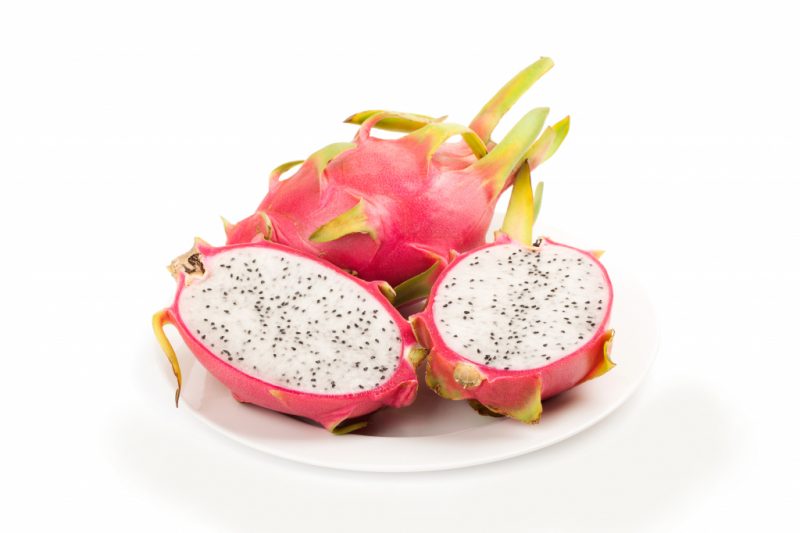
The mass of one fruit starts from 300 g and can reach 1 kg. The outer shell of the fruit is covered with interesting “scales” - small-sized leaves snugly adjacent to each other. It is they who give pitaya the resemblance to pineapple. However, in shape it resembles, rather, an apple.
It is interesting. The plant is a kind of record holder for fertility and can produce up to 6 crops per year.
Most of our compatriots tasted the fruit did not cause taste delight. The reason for this, most likely, was the immaturity of the fruit.And all because the transportation of ripe pitahaya is associated with certain difficulties - it is very difficult to transport a juicy fruit over long distances.
The fruit can be different in color both externally and internally, depending on the plant variety.
There are 3 varieties of pitaya:
- Red pitahaya. The most common variety. Strictly speaking, it is read only nominally red, since the peel of this fruit is pink, and the pulp of the fruit itself is white.
- Pink pitahaya. In appearance, it resembles the first option, with the only difference being that the flesh of this fruit is bright crimson.
- Yellow pitahaya has white flesh and does not appear on the shelves of our stores too often.
All 3 varieties are distinguished by taste.
The chemical composition of dragonfruit
The benefits of dragon fruit (yes, it is called pitahaya in our area) lie in its chemical composition, which includes 13% carbohydrates and a large amount of water. But fats and proteins are almost absent in overseas delicacies. Calorie pitaya is small - only 40 - 50 kcal per 100 g of product.
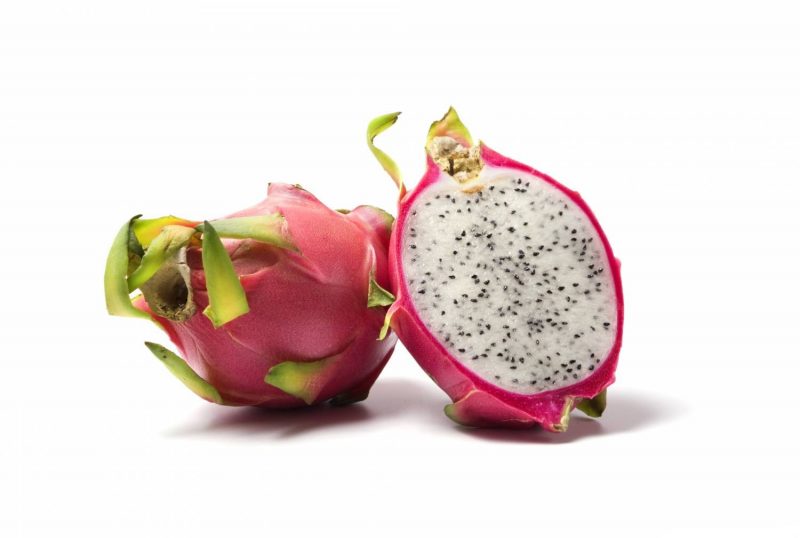
Also included in the composition of pitaya:
- cellulose;
- vitamins B, C;
- minerals: potassium, iron, phosphorus, etc.
Note. It should be noted that the chemical composition of the dragon fruit has not been thoroughly investigated.
What taste and smell does pitaya have
The taste of the exotic pitahaya fruit depends on its variety. The yellow fruit is considered the most saturated and resembles a mixture of banana with kiwi. Red fruits are fresher and have a lighter flavor.
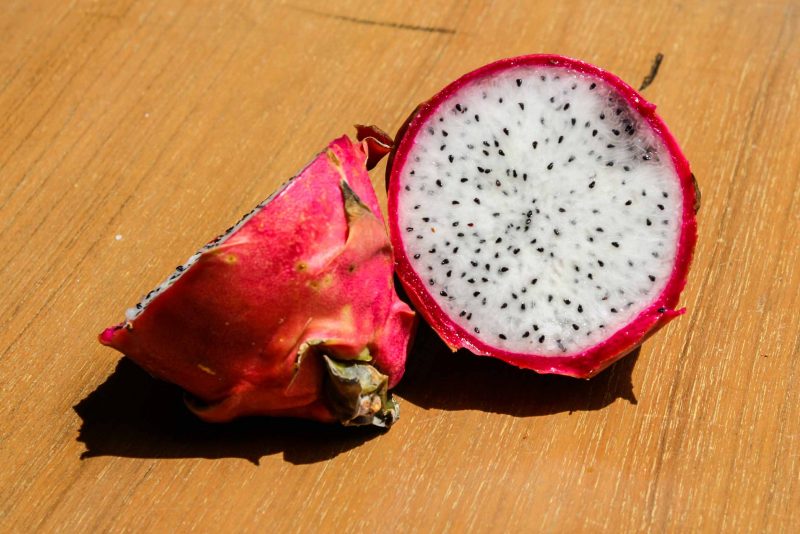
By the way. According to the reviews of dragon fruit tasters, they tasted the most delicious fruits not in Russia (which is not surprising), but in Vietnam.
How to eat exotic fruit
How to eat pitahaya? This fruit is almost universal, because it can be eaten fresh and added to salads. In addition, jams are made from the dragon fruit, as well as juices or wine.
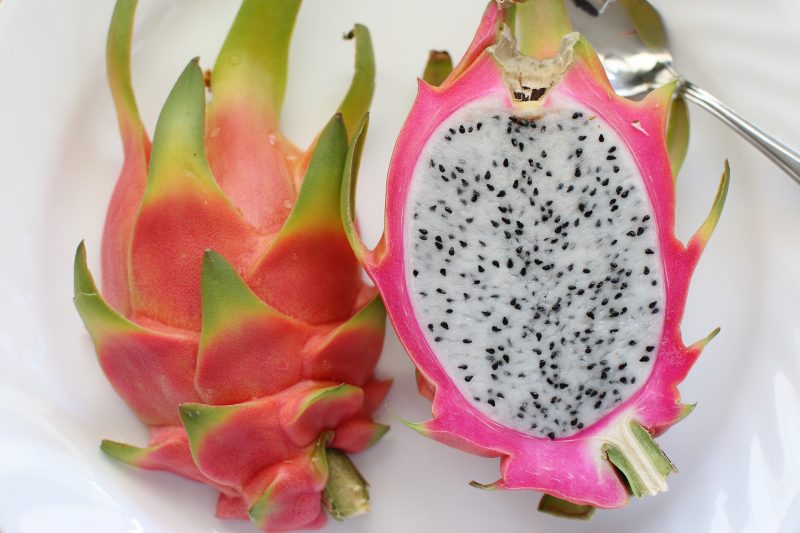
Some tips for cleaning pitaya:
- Fruit can be eaten unprocessed. For this, the fruit is cut into 2 halves and scoop up the pulp with a spoon from the resulting impromptu bowls.
- You can start to peel like a banana, from top to bottom. Thus, only a peeled core with small seeds, like kiwi, will remain in the hands.
- Cut the pitahaya in the manner of citrus slices.
- Lightly cut the peel and slide it down.
Fans of exotic dishes will surely like a pitahaya salad
Ingredients:
- pitaya - 1 pc.;
- Kiwi - 2 pcs.;
- strawberries - 5 pcs.;
- other fruits are optional.
- yogurt or fruit juice to taste.
Cooking:
Cut the dragonfruit into 2 halves and remove the pulp. Pitahaya and other fruits cut into cubes and mix. Top the mixture with yogurt or fruit juice.
Useful properties and contraindications
Pitahaya is a very useful product, despite its unusual and even somewhat frightening appearance.
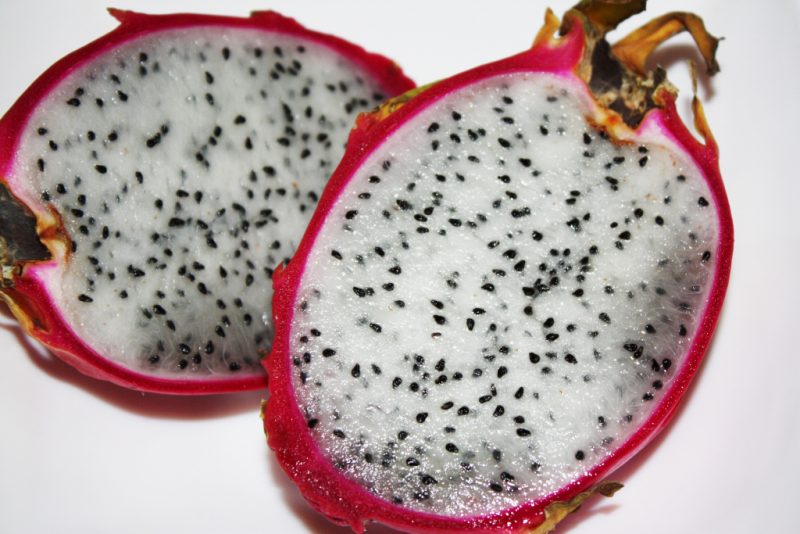
The main benefits of the fruit for the body are as follows:
- An impressive amount of fiber and low calorie make the fruit indispensable for diet. People seeking to lose extra pounds and cleanse the body should certainly pay attention to this delicacy.
- The ability to remove toxins and toxins from the body.
- Elimination of constipation.
- Increased immunity.
- Anti-inflammatory effect.
- Regulation of blood glucose.
- Slowing down the aging process in the body.
- External use of the pulp of the dragon fruit helps in the fight against wrinkles, and also helps to improve skin turgor and the healing of damaged tissues. It is for this reason that pitaya is used in folk medicine and cosmetology.
But despite all these advantages, the dragon fruit is not at all harmless.
So, before using it, you should consider a number of recommendations:
- Do not give fruit pulp to small children.
- People prone to allergic reactions should also be careful when enjoying the fetus.
- No need to consume a large amount of pitahaya for the first time.
- Product may cause diarrhea.
Note. After consuming a red fetus, the urine subsequently flowing out may have an identical hue. This phenomenon is not worth fearing.
How to choose and store fruit
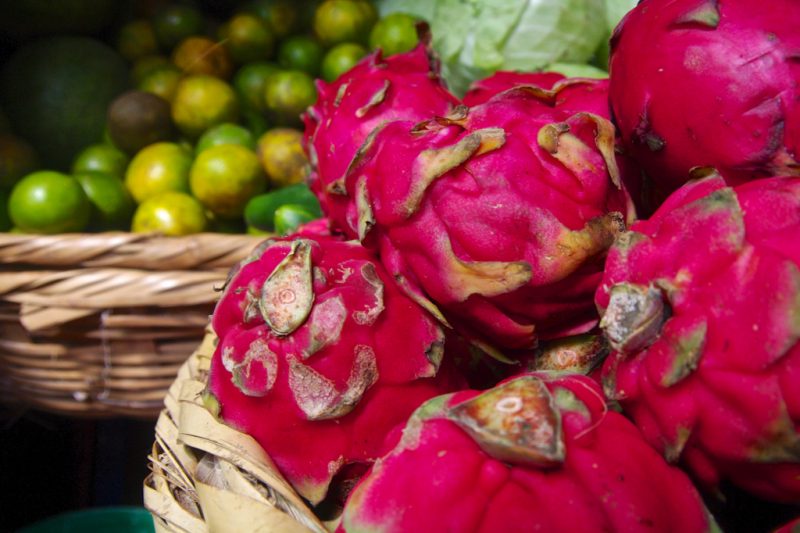
When choosing a dragonfruit, you should adhere to certain rules:
- The fruit should be slightly soft (like an avocado).
- If a solid specimen is caught upon purchase and the choice is limited, the fetus must be sent to “soften” in the refrigerator for a couple of days.
- Avoid buying overripe fruit. It can be identified by clearly marked dark spots on the surface.
- The peel of the fetus should be even and have a bright shade.
- Leaf growths should not be dry. Dead leaves are a sure sign that the fruit lies long after harvest.
Pitahaya is stored in the refrigerator for no more than 6 days. But it should be borne in mind that in a fresher product, beneficial properties are more pronounced.
Pitahaya is a fruit of transatlantic origin with original taste. In addition, the dragon fruit carries many useful substances for the body and its use will be useful for people who monitor their figure. Nevertheless, do not forget about moderation. It is important to monitor the body’s reaction to the new product being introduced, because people who are prone to allergies may experience an unexpected negative reaction to such a curiosity.












